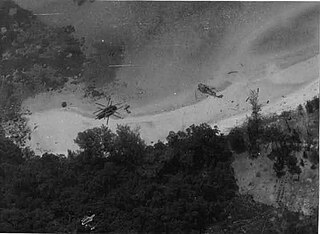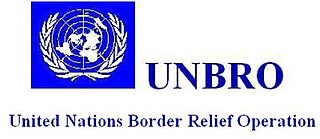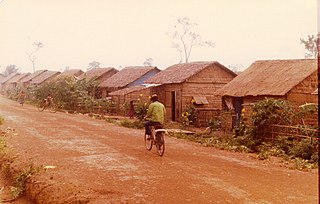
The Public Force are the military force of Monaco. However, the country has a very limited military capability and depends almost entirely upon its larger neighbour, France, for defence. In total, there are over 250 people employed as military personnel in some form. There is no conscription in Monaco.

Marshal Lon Nol was a Cambodian military officer and politician who served as Prime Minister of Cambodia twice, as well as serving repeatedly as defence minister and provincial governor. As a nationalist and conservative, he led the military coup of 1970 against Prince Norodom Sihanouk, abolished the monarchy, and established the short-lived Khmer Republic. Constitutionally a semi-presidential republic, Cambodia was de facto governed under a military dictatorship. He was the commander-in-chief of the Khmer National Armed Forces during the Cambodian Civil War and became President of the Khmer Republic on March 10th, 1972. On April 1, 1975, 16 days before the Khmer Rouge captured Phnom Penh, Lon Nol fled to the United States, first to Hawaii and then to California, where he remained until his death in 1985.

The Mayaguez incident took place between Kampuchea and the United States from 12 to 15 May 1975, less than a month after the Khmer Rouge took control of the capital Phnom Penh ousting the U.S.-backed Khmer Republic. After the Khmer Rouge seized the U.S. merchant vessel SS Mayaguez in a disputed maritime area, the U.S. mounted a hastily-prepared rescue operation. U.S. Marines recaptured the ship and attacked the island of Koh Tang where it was believed that the crew were being held as hostages. Encountering stronger-than-expected defences on Koh Tang, three United States Air Force helicopters were destroyed during the initial assault and the Marines fought a desperate day-long battle with the Khmer Rouge before being evacuated. The Mayaguez's crew were released unharmed by the Khmer Rouge shortly after the attack on Koh Tang began. The names of the Americans killed, including three Marines left behind on Koh Tang after the battle and subsequently executed by the Khmer Rouge, are the last names on the Vietnam Veterans Memorial.

The Kingdom of Cambodia, also known as the First Kingdom of Cambodia, and commonly referred to as the Sangkum period, refers to Norodom Sihanouk's first administration of Cambodia, lasting from the country's independence from France in 1953 to a military coup d'état in 1970. Sihanouk continues to be one of the most controversial figures in Southeast Asia's turbulent and often tragic postwar history. From 1955 until 1970, Sihanouk's Sangkum was the sole legal party in Cambodia.

Kriangsak Chamanan served as prime minister of Thailand from 1977 to 1980. After staging a successful coup, he was asked to become Prime Minister in 1977. He ruled till 1980 and is credited with "steering Thailand to democracy" in a time where communist insurgents were rampant internally and neighbouring countries turned to communist rule following the communist takeover of Vietnam: South Vietnam, Laos, and Cambodia.

The United Nations Border Relief Operation (UNBRO) was a donor-nation funded relief effort for Cambodian refugees and others affected by years of warfare along the Thai-Cambodian border. It functioned from 1982 until 2001.

The Cambodian–Vietnamese War was an armed conflict between Democratic Kampuchea, controlled by Pol Pot's Khmer Rouge, and the Socialist Republic of Vietnam. The war began with repeated attacks by the Kampuchea Revolutionary Army on the southwestern border of Vietnam, particularly the Ba Chúc massacre which resulted in the deaths of over 3,000 Vietnamese civilians. On 23 December 1978, 10 out of 19 of the Khmer Rouge's military divisions opened fire along the border with Vietnam with the goal of invading the Vietnamese provinces of Đồng Tháp, An Giang and Kiên Giang. On 25 December 1978, Vietnam launched a full-scale invasion of Kampuchea, occupying the country in two weeks and removing the government of the Communist Party of Kampuchea from power. In doing so, Vietnam put an ultimate stop to the Cambodian genocide, which had most likely killed between 1.2 million and 2.8 million people — or between 13 and 30 percent of the country’s population. On 7 January 1979, the Vietnamese captured Phnom Penh, which forced Pol Pot and the Khmer Rouge to retreat back into the jungle near the border with Thailand.

The Khmer People's National Liberation Front was a political front organized in 1979 in opposition to the Vietnamese-installed People's Republic of Kampuchea (PRK) regime in Cambodia. The 200,000 Vietnamese troops supporting the PRK, as well as Khmer Rouge defectors, had ousted the Democratic Kampuchea regime of Pol Pot, and were initially welcomed by the majority of Cambodians as liberators. Some Khmer, though, recalled the two countries' historical rivalry and feared that the Vietnamese would attempt to subjugate the country, and began to oppose their military presence. Members of the KPNLF supported this view.

Lon Non was a Cambodian military officer and politician who rose to prominence during the Cambodian Civil War (1967–1975) and the Khmer Republic (1970–1975).

The People's Republic of Kampuchea (PRK) was a partially recognised state in Southeast Asia which existed from 1979 to 1989. It was a satellite state of Vietnam, founded in Cambodia by the Vietnamese-backed Kampuchean United Front for National Salvation, a group of Cambodian communists who were dissatisfied with the Khmer Rouge due to its oppressive rule and defected from it after the overthrow of Democratic Kampuchea, Pol Pot's government. Brought about by an invasion from Vietnam, which routed the Khmer Rouge armies, it had Vietnam and the Soviet Union as its main allies.
After the 1978 Vietnamese invasion of Cambodia and subsequent collapse of Democratic Kampuchea in 1979, the Khmer Rouge fled to the border regions of Thailand, and, with assistance from China, Pol Pot's troops managed to regroup and reorganize in forested and mountainous zones on the Thai-Cambodian border. During the 1980s and early 1990s Khmer Rouge forces operated from inside refugee camps in Thailand, in an attempt to de-stabilize the pro-Hanoi People's Republic of Kampuchea's government, which Thailand refused to recognise. Thailand and Vietnam faced off across the Thai-Cambodian border with frequent Vietnamese incursions and shellings into Thai territory throughout the 1980s in pursuit of Cambodian guerrillas who kept attacking Vietnamese occupation forces.
The earliest traces of armed conflict in the territory that constitutes modern Cambodia date to the Iron Age settlement of Phum Snay in north-western Cambodia.
The Central Intelligence Agency of the United States conducted secret operations in Cambodia and in Laos for eight years as part of the conflict against Communist North Vietnam.

The United Front for the Liberation of Oppressed Races was an organization whose objective was autonomy for various indigenous peoples and ethnic minorities in South Vietnam, including the Montagnards in the Central Highlands, the Chams in Central Vietnam, and the Khmer Krom in Southern Vietnam. Initially a political movement, after 1969 it evolved into a fragmented guerrilla group that carried on simultaneous insurgencies against the governments of South Vietnam under President Nguyen Van Thieu and North Vietnam of Ho Chi Minh. Opposed to all forms of Vietnamese rule, FULRO fought against both sides in the Vietnam War against the Soviet-aligned North and the American-aligned South at the same time. FULRO's primary supporter during the 1960s and early 1970s conflict in Southeast Asia was Cambodia, with some aid sent by the People's Republic of China during the period of the Third Indochina War.
The United Nations Transitional Authority in Cambodia (UNTAC) was a peacekeeping mission established in the early 1990s following the civil war which broke out in Cambodia after the collapse of the Khmer Rouge regime in 1979. The Australian government had closely followed events in Cambodia given the possible implications for regional security, while out of a desire to be seen as a good international citizen it had also invested heavily diplomatically in order to push the parties towards a peace agreement. In August 1989 the UN attempted to broker a peace agreement between the warring factions, and included amongst the reconnaissance party were two Australian officers tasked with laying the groundwork for a monitoring force should it be deployed. However, after the collapse of the peace effort the proposed UN force was cancelled and the reconnaissance team withdrawn.
Sa Kaeo Refugee Camp was the first organized refugee relief camp established on the Thai-Cambodian border. It was built by the Royal Thai Government with support from international relief agencies including the United Nations. It opened in October 1979 and closed in early-July 1980. At its peak the population exceeded 30,000 refugees; no formal census was ever conducted.
The Khmer Special Forces, also designated 'Khmer SF' for short or Forces Speciales Khmères (FSK) in French, were the tier 1 special forces of the Khmer National Army (ANK), the land component of the Khmer National Armed Forces during the 1970-75 Cambodian Civil War.

The Khmer National Navy was the naval component of the Khmer National Armed Forces (FANK), the official military of the Khmer Republic during the Cambodian Civil War between 1970 and 1975.

The Cambodian humanitarian crisis from 1969 to 1993 consisted of a series of related events which resulted in the death, displacement, or resettlement abroad of millions of Cambodians.

The Royal Thai Army Special Warfare Command also known as Pa Wai Airborne is the special forces of the Royal Thai Army. Its headquarters are King Narai Camp in Lopburi.












